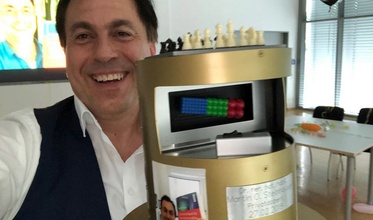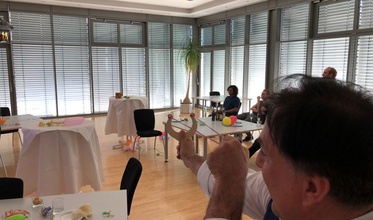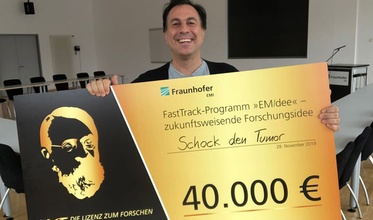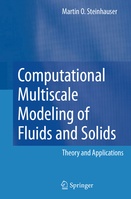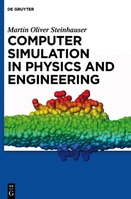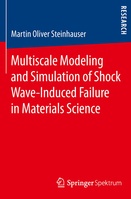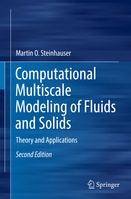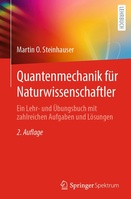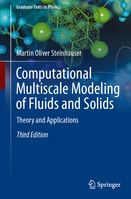Prof. Dr. rer. nat. habil. Martin O. Steinhauser
Professor of Physics and Computer Science
Sprechzeiten
Upon agreement via eMail. (Nach Vereinbarung per eMail)
Research Interests
- Computational Materials Science
- Multiscale Materials Modeling and Simulation
- Foundational Questions in Quantum Mechanics and Spacetime
- Quantum Chemistry
- High-Performance and Parallel Computing
- Monte-Carlo and Molecular Dynamics Simulations
- Shock Wave Physics and Material Failure
- Soft Matter and Statistical Physics
- Hypervelocity Impact and Space Debris
Lehre
SS 2025:
- Diskrete Mathematik mit Übung
- Physik I + Labor
WS 2024/25: Research Semester
SS 2024:
- Diskrete Mathematik mit Übung
- Physik I mit Übung + Labor
WS 2023/24:
- Analysis mit Übung
- Physik II mit Übung
- Computational Engineering Science
SS 2023:
- Diskrete Mathematik mit Übung
- Physik I mit Übung + Labor
WS 2022/23:
- Analysis I mit Übung
- Physik I mit Übung + Labor
- Computational Engineering Science
SS 2022:
- Analysis I mit Übung
- Physik I mit Übung + Labor
- Simulation und Optimierung mit Übung + Labor
WS 2021/22:
- Analysis I mit Übung
- Physik I mit Übung + Labor
- Computational Engineering Science
SS 2021:
- Analysis I
- Physik I
- Simulation und Optimierung mit Übung + Labor
WS 2020/21:
- Einführung in die Programmierung I mit Übung + Labor
- Physik I mit Übung + Labor
Beachten Sie folgendes: Bei Terminanfragen zur Besprechung von Bachelor- oder Masterarbeiten bitte eine Woche vorher ein Exposé im Umfang von einer bis max. zwei Seiten zusammen mit einem kurzen CV und einem Transkript Ihrer bisherigen Noten an mich schicken.
Das Exposé sollte die Fragestellung der Arbeit, zentrale Annahmen sowie Ideen zur Operationalisierung enthalten.
Anfragen zur Erstellung eines Gutachtens für Bewerbungen um ein Stipendium oder ähnliches müssen zusammen mit den entsprechenden Unterlagen (Lebenslauf, Zeugnisse, Leistungsnachweise) mindestens 4 Wochen vor Ende der Bewerbungsfrist eintreffen. Voraussetzung für ein Erfolg versprechendes Gutachten ist, dass der/die Bewerber/in aus mindestens einer Lehrveranstaltung bekannt ist und dort mindestens ein „Gut“ (1,7) erzielt wurde. Andernfalls können leider keine Gutachten verfasst werden.
Bitte berücksichtigen Sie, dass ich lediglich aufgrund der Teilnahme an einer Vorlesung und der damit verbundenen Note kein Vorschlagsgutachten bzw. eine Empfehlung verfassen kann. Ich kann aufgrund dieser Grundlage weder argumentieren, Sie hinreichend zu kennen, noch kann ich eine glaubwürdige und substanzielle Beurteilung Ihrer Diskussionsbeiträge und Ihrer Person verfassen. Hierfür sollten Sie dem Gutachter oder der Gutachterin aus einem Seminar bekannt sein.
Degrees/Education
Dr. rer. nat. habil. Martin O. Steinhauser studied Physics and Mathematics in Heidelberg, Ulm and Munich in Germany and at the University of Massachusetts at Amherst (UMASS), MA, USA. He earned a German Diploma in Physics at the University of Ulm, Germany in 1998 and earned his Ph.D in Physics at the Max-Planck-Institute for Polymer Research and the Johannes-Gutenberg University at Mainz, Germany in 2001 with Kurt Kremer and Kurt Binder. He also earned his Doctor Habilitatus (Dr. rer. nat. habil.) and his Venia Legendi and Venia Docendi in Physical Chemistry in 2018 at the Department of Chemistry at the University of Basel in Switzerland.
Biographical Details
After finishing his doctoral studies at the Max-Planck-Institute for Polymer Research in Mainz, Dr. Martin O. Steinhauser worked in leading positions in software industry (SAP AG, Walldorf) and in genomics & biotech industry (Lion Bioscience AG, Heidelberg). He joined the Fraunhofer Research Society in 2003 as Senior Scientist for Multiscale Modeling of Materials and High-Performance Scientific Computing at a Fraunhofer Research Institute in Freiburg, Germany. Since then he has been involved as manager and principal investigator in many national and international research projects in basic and applied science with budgets in the order of several million Euros. Since 2011 he is also an academic teacher and lectured in the Physics Department at the University of Freiburg, at Oxford University, UK, at Nanyang Technological University (NTU), Singapore, at the University of Basel in Switzerland and at the German-Jordanian University at Amman, Jordan. Since 2024 he is Guest Professor at the University of Tokyo, Japan. He is single author of several monographs on Computational Science and also wrote a standard textbook on Quantum Theory (in German) which was published in 2nd edition in 2023. He has a record of more than 50 invited and 7 plenary presentations at international conferences and published numerous original research papers. He has been reviewer for many international peer-reviewed journals and for several research organizations and scientific foundations. He is also founding member of the international Society of Ballistics and has more than 30 years of professional experience in Computational Science. In the year 2018 he earned his Doctor Habilitatus and the Venia Legendi and Venia Docendi in physical chemistry at the Department of Chemistry at the University of Basel in Switzerland. His main research interests are very interdisciplinary and focus on the behavior of soft and hard matter under high strain rates – in particular polymers and bio-membranes, shock wave physics, the physics of cancer cells, the measurement problem of quantum mechanics, quantum chemistry, numerical method development and high-performance scientific computing. In 2019 he won a research prize within the fast track program of the Fraunhofer Society for "visonary research ideas" related to molecular computer simulations and the physics of cancer cells. He joined Frankfurt University as Full Professor of Applied Physics and Computer Science in 2020.
My Research
Research Topics (Click on the Tiles)

Recent Research
- The growing threat of Space Debris.
- Self-organization of lipid molecules in membrane structures
Publications (Selection)
Marco Krummenacher and Martin O. Steinhauser
Self-assembly and complex formation of amphiphilic star and bottle-brush block copolymers
J. Chem. Phys, 157, 154904 (2022)
Martin O. Steinhauser
Multiscale modeling, coarse-graining and shock wave computer simulations in materials science
AIMS Materials Science, 4, 6, 1319-1357 (2017) doi: 10.3934/matersci.2017.6.1319
Martin O. Steinhauser
Novel Computer Simulations Adressing the Impact Risks in Space from Orbiting Debris
Mater. Sci. Eng., 1, 1005, 1-5 (2017)
Erkai Watson, Martin O. Steinhauser
Discrete Particle Method for Simulating Hypervelocity Impact Phenomena
Materials, 4, 379, 1-22 (2017)
Katja Schladitz, Andreas Büter, Michael Godehardt, Oliver Wirjadi, Johanna Fleckenstein, Tobias Gerster, Ulf Hassler, Katrin Jaschek, Michael Maisl, Ute Maisl, Stefan Mohr, Udo Netzelmann, Tobias Potyra, Martin O. Steinhauser
Non-destructive characterization of fiber orientation in reinforced SMC as input for simulation based design
Composite Structures 160, 195-203 (2017)
Martin Oliver Steinhauser, Tanja Schindler
Particle-based Simulations of bilayer membranes: Self-assembly, structural analysis, and shock wave damage
Comput. Part. Mech. 4, 69-86, (2017) doi:10.1007/s40571-016-0126-3
Martin Oliver Steinhauser
On the Destruction of Cancer Cells Using Laser-Induced Shock Waves: A Review on Experiments and Multiscale Computer Simulations
Radiol. Open J. 1, 60-75 (2016) doi:10.17140/ROJ-1-110
Tanja Schindler, D. Kröner, Martin O. Steinhauser
On the dynamics of molecular self-assembly and the structural analysis of bilayer membranes using coarse-grained molecular dynamics simulations
Biochimica et Biophysica Acta (BBA)-Biomembranes 1858, 1955-1963 (2016)
Martin Oliver Steinhauser
Discrete Particle Methods for Simulating High-Velocity Impact Phenomena
in: G. R. Liu and Shaofan Li (eds.): Proceedings of the International Conference on Computational Methods (ICCM 2016), 3, 915-923 (2016)
Martin Oliver Steinhauser, Mischa Schmidt
Destruction of Cancer Cells by Laser-Induced Shock Waves: Recent Developments in Experimental Treatments and Multiscale Computer Simulations
Soft Matter 10, 4778-4788 (2014)
Mischa Schmidt, Ulf Kahlert, Johanna Wessoleck, Donata Maciaczyk, Benjamin Merkt, Jaroslaw Macziaczyk, Jens Osterholz, Guido Nikkhah and Martin O. Steinhauser:
Characterization of a Setup to test the Impact of High-Amplitude Pressure Waves on Living Cells
Sci. Rep. 4, 3849 (2014)
M. O. Steinhauser:
Introduction to Molecular Dynamics Simulations: Applications in Hard and Soft Condensed Matter Physics
in Prof. Lichang Wang (ed): Molecular Dynamics - Studies of Synthetic and Biological Macromolecules, InTech (2012), DOI: 10.5772/36289, ISBN: 978-953-51-0444-5, Available from: https://www.intechopen.com/books/molecular-dynamics-studies-of-synthetic-and-biological-macromolecules
M. O. Steinhauser
Modeling Dynamic Failure Behavior in Granular and Biological Materials: Emerging New Applications
Cover page article in Y. M. Haddad (ed): AES Technical Reviews, International Journal Part C, IJATEMA 1, 1-19 (2012), ISSN: 1916-5366
G. C. Ganzenmüller, S. Hiermaier and M. O. Steinhauser
Energy-Based Coupling of Smooth Particle Hydrodynamics and Molecular Dynamics
Eur. Phys. J. Special Topics 206, 51-60 (2012)
G. C. Ganzenmüller, S. Hiermaier and M. O. Steinhauser
Consistent Temperature Coupling with Thermal Fluctuations of Smooth Particle Hydrodynamics and Molecular Dynamics
PLoS ONE 7, e51989 (2012)
G. C. Ganzenmüller, S. Hiermaier and M. O. Steinhauser
Multiscale Modeling and Simulation of Shock-Wave Impact Failure in Hard and Soft Matter
in K. Kontis (ed): Shock Waves, Springer Verlag, Heidelberg (2012), ISBN 978-3-642-25687-5
G. C. Ganzenmüller, S. Hiermaier and M. O. Steinhauser
Shock-Wave Induced Damage in Lipid Bilayers: A Dissipative Particle Dynamics Simulation Study
Soft Matter 7, 4307 (2011)
M. O. Steinhauser, J. Schneider and A. Blumen
Simulating Dynamic Crossover Behavior of Semiflexible Linear Polymers in Solution and in the Melt
J. Chem. Phys. 130, 164902 (2009)
M. O. Steinhauser and S. Hiermaier
A Review of Computational Methods in Materials Science: Examples from Shock-Wave and Polymer Physics
Int. J. Mol. Sci. 10, 5135 (2009)
M. O. Steinhauser, K. Grass, E. Strassburger and A. Blumen
Impact Failure of Granular Materials -- Non-Equilibrium Multiscale Simulations and High-Speed Experiments
Int. J. Plasticity 25, 161 (2009)
Martin O. Steinhauser
Failure of Granular Materials under Impact: Modeling and Multiscale Simulations
in E. Oñate and D. R. J. Owen (ed): Particles 2009, CIMNE, Barcelona (2009)
M. O. Steinhauser
Static and Dynamic Scaling of Semiflexible Polymer Chains -- A Molecular Dynamics Simulation Study of Single Chains and Melts
Mech. Time-Depend. Mater. 12, 1385 (2008)
M. Kühn and M. O. Steinhauser
Modeling and Simulation of Microstructures using Power Diagrams: Proof of Concept
Appl. Phys. Lett. 93, 034102 (2008)
M. O. Steinhauser, J. Schneider and A. Blumen
Equilibrium and Non-Equilibrium Molecular Dynamics Simulations of Flexible and Semiflexible Polymer Melts
in R. B. Hall, H. Lu and H. J. Qi (eds): Mechanics of Time-Dependent Materials, Current Associates, 57, Moorehouse Lane, Red Hook, NY, USA pp. 12571 (2008)
M. O. Steinhauser and M. Kühn
The Use of Optimized Power Diagrams for Mesoscopic Shock Wave Modeling
in A. Khan, B. Farrokh (eds): Plasticity of Conventional and Emerging Materials: Theory and Applications, Neat Press, Cleveland, Ohio, USA pp. 322 (2007)
M. O. Steinhauser
Computational Methods in Polymer Physics
Chapter in Recent Res. Devel. Physics 7, 59 (2006), ISBN 81-7895-237-8
M. O. Steinhauser, K. Grass, K. Thoma and A. Blumen
Impact Dynamics and Failure of Brittle Solid States by Means of Nonequilibrium Molecular Dynamics Simulations
Europhys. Lett. 73, 62 (2006)
M. O. Steinhauser and M. Kühn
Numerical Simulation of Fracture and Failure Dynamics in Brittle Solids
in A. Khan, S. Kohei and R. Amir (eds): Anisotropy, Texture, Dislocations, Multiscale Modeling in Finite Plasticity and Viscoplasticity and Metal Forming, Neat Press, Maryland, USA pp. 634 (2006)
M. O. Steinhauser and M. Kühn
Modeling of Shock-Wave Failure in Brittle Materials
in P. Gumbsch (ed): MMM Multiscale Materials Modeling, IRB Publishing, Stuttgart, Germany pp. 380 (2006)
M. Kschischo, R. Kern, C. Gieger, M. O. Steinhauser and R. Tolle
Automatic Scoring and Quality Assessment using Accuracy Bounds for FP-TDI SNP Genotyping Data
Applied Bioinformatics 4, 75 (2005)
M. O. Steinhauser and K. Grass
Failure and Plasticity Models of Ceramics. A Numerical Study
in A. Khan, S. Kohei and R. Amir (eds): Dislocations, Plasticity, Damage and Metal Forming, Materials Response and Multiscale Modeling, Neat Press, Maryland USA, pp. 370 (2005)
M. O. Steinhauser
A Molecular Dynamics Study on Universal Properties of Polymer Chains in Different Solvent Qualities. Part I. A Review of Linear Chain Properties
J. Chem. Phys. 122, 094901 (2005)
K. Grass, A. Blumen, M. O. Steinhauser and K. Thoma
Sequential Modeling of Failure Behavior in Cohesive Brittle Materials
in R. Garcia-Roja, H.-J. Herrmann, S. McNamara (eds): Powders and Grains, A. A. Balkema Publishers, Leiden, pp. 1447 (2005)
M. O. Steinhauser und K. Thoma
MMM-Tools: Multiskalen Modellierung und -Simulation
in Congress Intelligente Leichtbausysteme (ILS), Vogel Industrie Medien, Wolfsburg, pp. 56 (2004)
B. Dünweg, D. Reith, M. O. Steinhauser and K. Kremer
Corrections to Scaling in the Hydrodynamic Properties of Dilute Polymer Solutions
J. Chem. Phys. 117, 914 (2002)
R. G. Winkler, M. O. Steinhauser and P. Reineker
Complex Formation in Systems of Oppositely Charged Polyelectrolytes: A Molecular Dynamics Simulation Study
Phys. Rev. E 66, 021802 (2002)
Martin O. Steinhauser
Computational Multiscale Modeling of Fluids and Solids - Theory and Applications
Springer, Heidelberg, Berlin, 2008
Martin O. Steinhauser
Computer Simulation in Physics and Engineering
de Gruyter, Leipzig, Berlin, Boston, 2013
Martin O. Steinhauser
Quantenmechanik für Naturwissenschaftler
Springer, 2. Auflage, Heidelberg, Berlin, 2017
Martin O. Steinhauser
Multiscale Modeling and Simulation of Shock Wave-Induced Failure in Materials Science
Springer, Heidelberg, Berlin, 2018
Martin O. Steinhauser
Computational Multiscale Modeling of Fluids and Solids - Theory and Applications
3rd revised and expanded edition, Springer Spektrum Schweiz, Basel, 2017
Martin O. Steinhauser
Quantenmechanik für Naturwissenschaftler
Springer, 2. Auflage, Heidelberg, Berlin, 2022
Martin O. Steinhauser
Computational Multiscale Modeling of Fluids and Solids - Theory and Applications
Springer, Heidelberg, Berlin, 2022
Research Topics for writing a Thesis
I am offering research topics for master students who want to work towards a PhD with me, earn their master thesis or are just interested in working on a research project with me.
The topics are in the context of applications of Computational Sciences in:
- Biophysics,
- Polymer Physics,
- Biochemistry,
- Research of Materials under Shock and Load,
- Shock Wave Research,
- Numerical Method Development,
- Parallel Computing and Algorithms
and will require very good programming skills in C/C++, the willingness to acquire good knowledge of Statistical Physics and to extend existing research codes.
If you are interested, feel free to contact me after one of my lectures or write eMail to me to make an appointment for discussing details after you have read the following details:
If you are interested in doing a project or theses with me, please carefully read this page first and then send an e-mail with the following information:
- An acknowledgement that you have carefully read this whole page and the pages linked or branching from it.
- A list of the courses you have already taken with me.
- A short CV with a very short description of your interests and your strengths (concerning work on a project/thesis).
- A transcript of the grades of the courses you have taken so far.
- If you have an own project in mind (not necessary): a very short description of the goal and the scientific merit.
If you want to do your thesis with a company or another department, please provide the following "additional" information in a concise format. Concise means that you should not write more than a paragraph for each of the items below and that your text should be concrete and understandable for a non-expert. The purpose of this information is so that I can check whether the planned work has sufficient scientific merit with respect to the field of computer science.
- What is the expected / aimed at outcome?
How does your approach and the expected result differ from the state of the art?
How do you plan to evaluate your work?
- Supervision must be provided by the company or the other department and the supervisor should provide an evaluation report at the end of the thesis, in a format to be discussed with me.
Grading scheme for a Thesis
Your final grade for the thesis will be an average of four grades, one for each of the following four aspects:
- Quality of the conceptual/theoretical work. This includes aspects such as:
- How well were the ideas thought out / the details worked out
- How independent was the work
- How meaningful and interesting/useful were the results
- Quality of the implementation work. This includes aspects such as:
- Did you submit the full source code of your thesis
- How easily can we reproduce your work and your results
- Is the code well documented, did you adhere consequently to a proper coding style
- Quality of the evaluation. This includes aspects such as:
- Is the experimental/numerical setup well described
- If Applicable: Is the selection of datasets reasonable (there should be at least two, with different characteristics)
- Is there a comparison with a reasonable baseline or competitor method
- Are the results correct
- Are the results properly discussed
- Quality of the write-up. This includes the aspects of:
- Style of writing: Interesting and enlightening or boring with many unnecessary repetitions
- Useful layout of the thesis as a whole: Titlepage, chapters, sections, TOC, TOF, etc.
- Usefule citations, correct bibliography with a unique citation style
- Number of pages
- Orthography: Correct spelling and correct use of grammar
In this section, we discuss five golden rules: "simple sentences", "well-defined terms", "consistency", "be concrete", and "clear context". If you follow all five, your paper will be easy to read and understand. If you neglect only one of these rules, reading your paper will be no fun and it will be hard or even impossible to understand what you wanted to say. The subsections below give a short description for each of these rules.
Simple sentences
A very simple but important rule of thumb is: write simple sentences. A simple sentence has the form: subject, predicate, object. If your sentence has two or more verbs, consider splitting it into two simpler sentences. It is rarely necessary to have sentences with more than two verbs. The sentences in this document are good examples for this writing style.
As a counterexample, this sentence, which is rather convoluted due to various reasons, including, for example, these nested relative clauses, puts a rather heavy cognitive load on the reader and is also simply too long by way of making several statements all in one sentence which could have just as well been made in, you can guess it, multiple sentences, one sentence per statement.
You get the idea! Note that using simple sentences may not be the best style when writing a novel. But it is perfect for scientific text, because it is easy to read and easy to understand.
Well-defined terms
Whenever you use a term that is not commonly understood, you have to define it first. You can assume that your reader has a basic education in computer science, but not more.
For example, you don't have to define what an "algorithm" is. But when you say something about the "shortest-path problem", you should first define what the shortest-path problem is. Even if your readers have heard about the shortest-path problem in general, it's important to clarify which particular variant you are talking about.
On rare occasions, it might make sense to explain a term in the sentence right after the one where you introduce it. If you do that, it should really be the very next sentence. And this construct should really be the exception, and not the rule. If you use a term many pages after its definition and after it has last been used, it's usually a good idea to remind the reader of the definition. For example, you could refer to the definition or remind the reader what the term means or both.
Consistency
If you use a particular word to describe something, stick to that word. Variation is maybe nice in a novel. But in scientific work, every single inconsistency makes it harder for the reader. It is also fine to repeat the same word again in the next sentence. In scientific work, this is even good style.
For example, it is perfectly OK to write: "In this section, we describe the details of our algorithm. The algorithm proceeds in two phases". You might be tempted to write the second sentence as "It proceeds in two phases". This would actually make the text harder to read because a reader has to resolve what "It" refers to (it could refer to "our algorithm", but also to "this section"). It would be even worse to write "The procedure proceeds in two phases". Now you have introduced a new word and the reader will be confused about whether "The procedure" is referring to "our algorithm" or maybe something else which they have overlooked.
Visual consistency is also important. If you use different fonts, use them with a consistent meaning. If you have multiple tables or figures in your thesis, make sure they have a consistent look.
Be Concrete
Be concrete, as opposed to vague. It is very easy to be vague with natural language. This is especially true if you have not fully understood something or if you don't know the details, but you want to make a statement nevertheless.
An example of a vague sentence is: "We show that our algorithm is much better than previous ones". First, the quality measure is not clear: better in exactly which way? Second, it is not clear how much better: 10% better, twice better, ten times better? Third, which previous algorithms: all of them them, some of them, and if only some of them, which ones?
Concreteness is particular important in the parts, when you define your problem or describe your solution or your experimental setup. For example, consider: "The goal of this paper is to get text from PDF documents". This sentence is unconcrete on so many levels. What does "get" mean, in which format should be text be "gotten", what constitutes a good solution, etc.
Provide Clear context
The first four rules are easy to understand and check. This fifth rule is a bit more subtle, but just as important as the previous four rules. Often a text is hard to read or understand and you can't really put your finger on why. That is usually because there are many sentences, where the context is unclear or missing.
So what does context refer to? When you explain something non-trivial, you need multiple sentences. Each sentence of your explanation will refer to entities or statements from earlier sentences. It is important that it is 100% clear what these references refer to. Otherwise the reader has to pause and think or even guess, both of which are a major nuisance when reading.
For example, consider the sentence "We bridge the gap between entities and text using automatic information extraction". This sentence is impossible to understand in isolation. It speaks of "the gap between entities and text". To understand it, one needs to understand: (1) what exactly "entities" refers to, (2) what exactly "text" refers to, and (3) what exactly is meant by the "gap" between these two. If the immediately preceding sentences make this clear, the sentence is fine. If they don't make it clear, the sentence remains cryptic.
Note that another issue with the example sentence might be the term "automatic information extraction". That term would be OK if it has been defined before or if it is defined right in the next sentence. If only "information extraction" was defined, the "automatic" would be an example of a vague term that is not concrete enough (Golden Rule #4).
English or German?
You can write your thesis in German or in English. If you write it in English, more people will read it. Plus, it's a great opportunity to practice writing in English. You will almost certainly need that ability in your later job, so why not start now. If you don't want anyone to read your thesis, write it in French or Latin.
American English or British English?
American English please. For example, write analyze (AE) and not analyse (BE). Write neighbor (AE) and not neighbour (BE). Write labeling (AE) and not labelling (BE). As a rule of thumb: if two variants of a word come to your mind, use the ones with less letters and the one with a z instead of an s.
How much should I write?
A typical question is: how much should I write? My typical answer is: write as much as is necessary to understand what you did, how you were doing it, and all the aspects listed in the section Structure of a thesis below. No more, no less. The thesis should be self-contained. That is, for someone with a basic education in computer science, it should not be necessary to read anything else than your thesis in order to understand all the main aspects of your thesis.
How much related work should I look at?
Whatever you do, there is probably lots of previous work at least on the general topic of your project or theses, and maybe even on the particular problem you are dealing with. Screening all this work (and first finding it, which can also be non-trivial) can take an arbitrary amount of time and easily several months. This gives rise to the question, how much time you should spend on it and when.
The short answer is that you should avoid the two extremes. One extreme is to ignore previous work until you are done with the thesis and then do a few Google searches to hack together a related work section. The other extreme is to spend many months on finding and screening related work before even starting to work on the problem yourself.
A good compromise is as follows. Before you start with your work, spend a day or so on searching the web (in particular, Google Scholar) on the general topic of your project or thesis. If you don't find anything on the particular problem you are dealing with, widen your search. There certainly is something about the general topic. Often, other people use other terminology to describe very similar or even the same things. So be creative when searching.
One good strategy is to look for well-cited papers or surveys. Such papers serve three purposes. First, the paper itself will tell you something interesting about the topic and the state of the art. Second, the paper will provide references to other work that might be relevant. Third -- and this is relevant especially if the paper is already a bit older -- you can look for newer papers citing this paper (this is easy in, say, Google Scholar). Note that all three only work well for high-quality papers, hence the remark about the citation count. A low-quality paper might be unaware of other related work and it might be ignored by the community and is hence not cited by other related work. (However, also great papers are sometimes ignored by future papers on a related topic because the authors of those papers did not do their homework.)
However, don't wait too long before starting your own work. But don't forget to look for related work either. While you work on the problem yourself, you should keep looking for related work as a background process. The more you understand about the problem yourself, the easier it will be to find other related work. Keep note of these works. In fact, it's best to write a paragraph or two about each paper you encounter right when you encounter it. That way, you will already have all the material you need when you have to write your Related Work section in the end.
For how to actually write the Related Work section, see the corresponding subsection the section Structure of a thesis below.
"We" or "I" or passive voice?
There is no clear answer or recommendation for that one. Look at peer-reviewed research papers and notice the style of writing. If you want to use "We", that is ok also if you are the only author. In many contexts, "we" can be interpreted as "the reader and I". "I" is very rarely used in scientific writing.
Spelling, Hyphens, Commas
As a final step, ALWAYS run a spell checker over your write-up. It is very embarrassing indeed if your write-up contains mistakes that any spell checker would have found.
Computer-science articles contain many multi-word noun phrases. A common question is when (not) to put a hyphen. There is actually a clear and simple rule for this: multi-word noun phrases have a hyphen only if you use them as an adjective. Here is an example: (1) This problem has a large scale. (2) This is a large-scale problem. Putting a hyphen in (1) would be a mistake. Not putting the hyphen in (2) would be a mistake. Understand the purpose of the hyphen. It says what belongs together. In sentence (2), without the hyphen, it would not be clear whether it is a "scale problem" that is large, or whether the problem has a "large scale".
Another common question is when (not) to put a comma. The rules in the English language are less strict than in the German language, but they are still pretty clear in most cases. For example, you should always put a comma after introductory clauses like "However", "In this section", "Therefore", ... You should also always include relative clauses into commas. As a rule of thumb: when you have two statements in one sentence and the separation of the two statements is not 100% clear, put a comma to clarify this. That is, in fact, the main purpose of a comma.
Finally, commas can save lives. For example: Let's eat, Grandma.
Structure of a thesis
This section provides a list of the typical elements of a thesis, together with short descriptions. In facts, these are the typical elements of any scientific article or paper.
Every section and every subsection -- except the Abstract and the Introduction -- should start with a small introduction that tells the reader what comes next. The following four sentences are an example: "In this section, we will give a high-level description of the algorithm. The algorithm has two phases. In the first phase, ... (Section 3.1). In the second phase, ... (3.2)." Note how simple the sentences are (Golden Rule #1).
A good way to start your write-up is to write down all the section and subsection headers. The names of the headers should be carefully chosen, and they should be consistent in their style.
Title
As a minimum, a title should be informative. Think of it as the shortest way to summarize your work in one short sentence. A secondary criterion is that it is catchy. This is not necessary, however, and sometimes hard to achieve. Also a catchy title should be informative. If you build a system, a typical title is the name of the system, followed by a colon, followed by a short description of what the system does. Avoid titles that cannot be understood before reading any of the contents.
Abstract
An abstract should be self-contained and understandable to a non-expert. Think of it as the shortest way to summarize your work in one paragraph. As a minimum, it should clarify the problem dealt with in the thesis, and the main results that were obtained. If a short example can be given, it should be given, but this is not always possible. If space permits, add a sentence or two about the underlying techniques and how the thesis advances the state of the art.
Introduction
An introduction should be self-contained and understandable to a non-expert. Think of it as the shortest way to summarize your work in a couple of pages. As a minimum, it should clarify the problem dealt with, the motivation for dealing with that problem, the main results, the main challenge and the line of attack used to overcome it, and how it advances the state of the art. In the abstract, you have only one or two sentences (if any) for each of these aspects. In the introduction, you have more space. For the problem statement, it is almost always a good idea to provide a figure or screenshot with a (carefully chosen) example.
One common mistake (and nuisance) is to have relative vague and informal statements in the introduction and then later a separate section with a more formal problem statement. The corresponding reader experience is that upon first reading one either does not understand the introduction or does not find it very useful or both. You can fix this as follows: whatever is relatively easy to understand and can already be defined in the introduction should already be defined in the introduction.
Related Work
Also see the FAQ "How much related work should I look at?" above.
Most probably, other researchers have worked on the problem of your thesis, or a strongly related problem, before. Your thesis should include a section which summarizes the most relevant of these works. Typically this is Section 2, right after the Introduction. For each of these works, it should be explained in a nutshell what they do, what they achieve, and how this differs from what you do in your thesis. This should be understandable without the need to actually read the papers referred to. For each related work, think of the description as the shortest way to say this in one paragraph.
When there is a lot of work about a particular topic / problem, it is ok to focus on the most recent / most advanced approaches. Where there is no work on the exact problem from your thesis, the Related Work section should be about work on similar problems and it should explain how these related problems differ. Note that sometimes a problem looks different only on the surface, and the solutions can actually be applied to your problem as well.
Future work
Most probably, your work will leave various open ends. Make a list of what could be done next to improve on what you did. For each item, give a short description of the possible improvement + an idea for how, in principle, it could be achieved. Also give an estimate for the necessary time to realize that improvement (hours, days, weeks, months). Order your list by importance / significance. That is, the thing that should be improved next / gives the biggest improvement should come first.
Bibliography
Make sure that the entries in your bibliography have a consistent style. That is, abbreviate all conferences in the same way or use the full names for all, but do not mix the two styles. Same for author names. Same for capitalization of titles. Same for page numbers. It makes a very careless and untidy impression if the bibliography entries are inconsistent in their style. Note that it would be a mistake to put a comma before the "if" in the previous sentence.
- Modeling and simulation of space debris impact on satellite structures.
- Simulating material failure with machine learning approaches.
- Simulation of polyelectrolyte complex formation.
- Investigation of the interaction of macromolecules with biomembranes and vesicles.
- Exploring the effects of shock waves on biological cells and cellular structures.
- Modeling and simulation of a polymer network with crosslinkers as a model of a cell's cytoskeleton.
- Static and dynamic properties of hyperbranched polymers and Viscek fractals.
- Development of an efficient, optimized and parallelized molecular dynamics computer program.
- Other topics upon personal agreement...
Former Graduate Students (until 2019)
This is a list of my former graduate students who worked scientifically under my supervision earning their Diploma, respectively their Master of Science. The theses were submitted to and published at different home universities as listed.
Details
Year | Student | Thesis |
2019 | Marco Krummenacher | Master Thesis (26.09.2019): |
2015 | Erkai Watson | Master Thesis (30.11.2015): |
2013 – 2014 | Tanja Schindler | Diploma Thesis (28.04.2014): |
2012 – 2013 | Yannick Bienfait | Master Thesis (18.12.2013): |
2007 -2008 | Tobias Pardowitz | Diploma Thesis (3.12.2008): |
2006 – 2007 | Julian Schneider | Diploma Thesis (17.10.2007): |
2005 – 2006 | Dr. Martin Kühn | Diploma Thesis (18.7.2006): |
2004 – 2005 | Kai Grass | Diploma Thesis (22.06.2005): |



